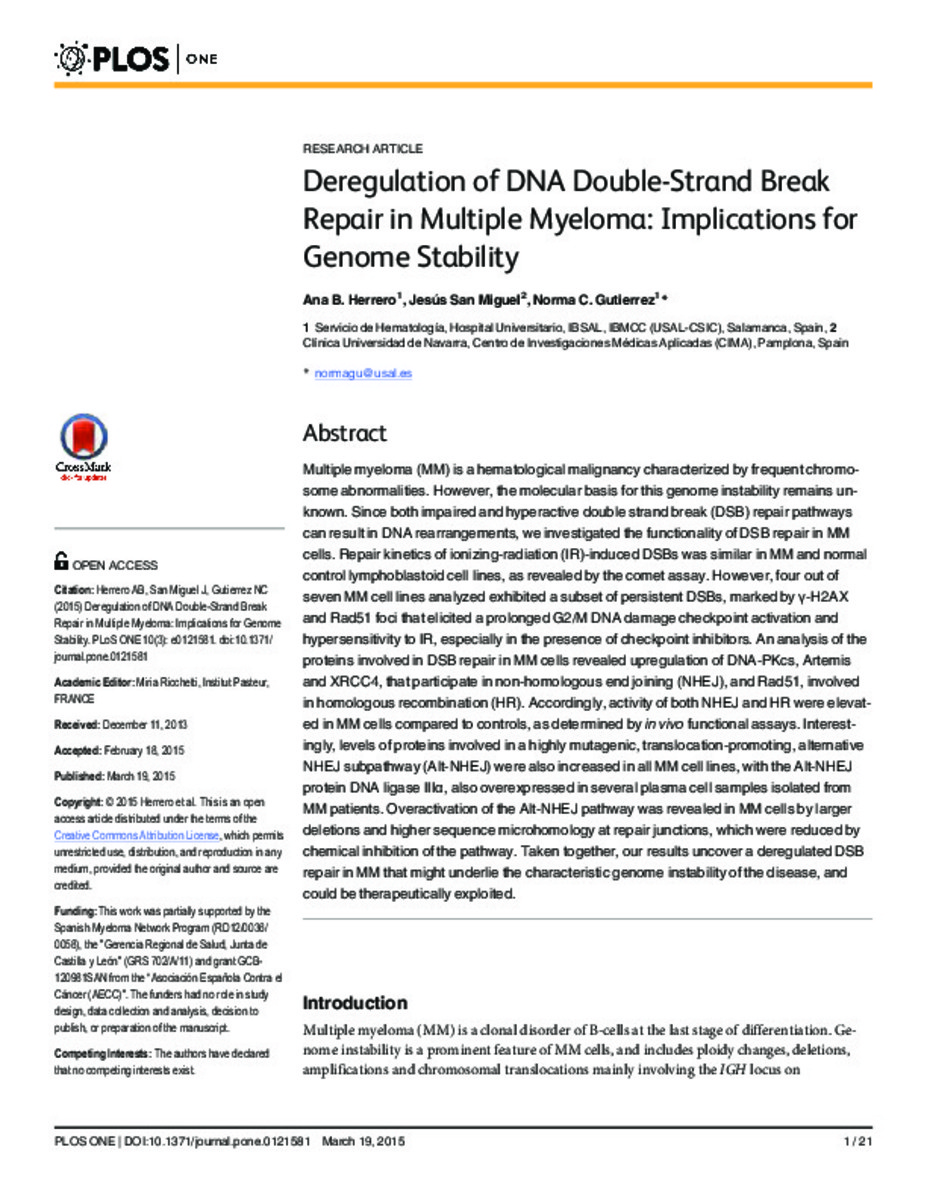Registro completo de metadatos
| Campo DC | Valor | Lengua/Idioma |
|---|---|---|
| dc.creator | Herrero, A.B. (Ana B.) | - |
| dc.creator | San-Miguel, J.F. (Jesús F.) | - |
| dc.creator | Gutierrez, N.C. (Norma C.) | - |
| dc.date.accessioned | 2015-05-05T14:18:27Z | - |
| dc.date.available | 2015-05-05T14:18:27Z | - |
| dc.date.created | 2015 | - |
| dc.date.issued | 2015 | - |
| dc.identifier.citation | Herrero AB, San Miguel J, Gutierrez NC. Deregulation of DNA Double-Strand Break Repair in Multiple Myeloma: Implications for Genome Stability. PLoS ONE 2015;10(3): e0121581. | es_ES |
| dc.identifier.issn | 1932-6203 | - |
| dc.identifier.uri | https://hdl.handle.net/10171/38239 | - |
| dc.description.abstract | Multiple myeloma (MM) is a hematological malignancy characterized by frequent chromosome abnormalities. However, the molecular basis for this genome instability remains unknown. Since both impaired and hyperactive double strand break (DSB) repair pathways can result in DNA rearrangements, we investigated the functionality of DSB repair in MM cells. Repair kinetics of ionizing-radiation (IR)-induced DSBs was similar in MM and normal control lymphoblastoid cell lines, as revealed by the comet assay. However, four out of seven MM cell lines analyzed exhibited a subset of persistent DSBs, marked by γ-H2AX and Rad51 foci that elicited a prolonged G2/M DNA damage checkpoint activation and hypersensitivity to IR, especially in the presence of checkpoint inhibitors. An analysis of the proteins involved in DSB repair in MM cells revealed upregulation of DNA-PKcs, Artemis and XRCC4, that participate in non-homologous end joining (NHEJ), and Rad51, involved in homologous recombination (HR). Accordingly, activity of both NHEJ and HR were elevated in MM cells compared to controls, as determined by in vivo functional assays. Interestingly, levels of proteins involved in a highly mutagenic, translocation-promoting, alternative NHEJ subpathway (Alt-NHEJ) were also increased in all MM cell lines, with the Alt-NHEJ protein DNA ligase IIIα, also overexpressed in several plasma cell samples isolated from MM patients. Overactivation of the Alt-NHEJ pathway was revealed in MM cells by larger deletions and higher sequence microhomology at repair junctions, which were reduced by chemical inhibition of the pathway. Taken together, our results uncover a deregulated DSB repair in MM that might underlie the characteristic genome instability of the disease, and could be therapeutically exploited | es_ES |
| dc.language.iso | eng | es_ES |
| dc.publisher | Public Library of Science | es_ES |
| dc.rights | info:eu-repo/semantics/openAccess | es_ES |
| dc.subject | Myeloma | es_ES |
| dc.subject | Genome | es_ES |
| dc.subject | DNA | es_ES |
| dc.title | Deregulation of DNA double-strand break repair in multiple myeloma: implications for genome stability | es_ES |
| dc.type | info:eu-repo/semantics/article | es_ES |
| dc.editorial.note | Attribution 4.0 International (CC BY 4.0) | es_ES |
| dc.identifier.doi | http://dx.doi.org/ 10.1371/journal.pone.012158 | es_ES |
Ficheros en este ítem:
Estadísticas e impacto
Los ítems de Dadun están protegidos por copyright, con todos los derechos reservados, a menos que se indique lo contrario.






